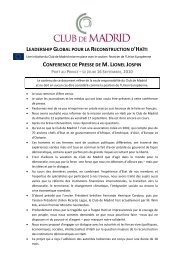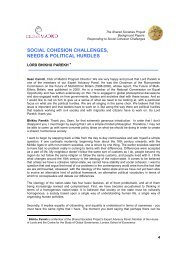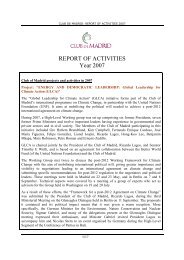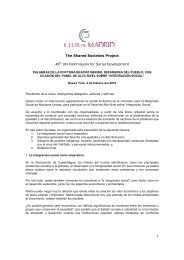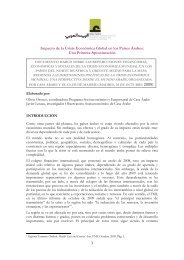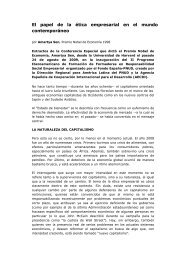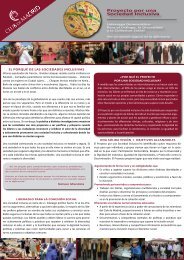Investing cultural diversity and intercultural dialogue - Business and ...
Investing cultural diversity and intercultural dialogue - Business and ...
Investing cultural diversity and intercultural dialogue - Business and ...
You also want an ePaper? Increase the reach of your titles
YUMPU automatically turns print PDFs into web optimized ePapers that Google loves.
22 . PART II – KEY VECTORS OF CULTURAL DIVERSITY<br />
I Statues of the Holy Virgin<br />
Mary in a souvenir shop in<br />
Lourdes, France<br />
ii A multinational<br />
business team joining<br />
h<strong>and</strong>s<br />
i Street art in Rio de<br />
Janeiro, Brazil<br />
K Ecuadorean blankets<br />
Recent research<br />
suggests the<br />
existence of a<br />
positive link<br />
between <strong>diversity</strong><br />
<strong>and</strong> the financial<br />
<strong>and</strong> economic<br />
performance of<br />
multinational<br />
corporations<br />
Tourism plays an important role in combining profitmaking<br />
initiatives with the promotion of inter<strong>cultural</strong><br />
<strong>dialogue</strong>. After decades of so-called mass tourism, we are<br />
experiencing a renewal of tourism in search of<br />
authenticity, which is motivated by the desire to discover<br />
other people in their natural, social <strong>and</strong> <strong>cultural</strong> settings.<br />
So-called ‘<strong>cultural</strong> tourism’, which includes forms of<br />
religious tourism <strong>and</strong> tourism linked to World Heritage<br />
sites, can help to promote <strong>cultural</strong> underst<strong>and</strong>ing by<br />
situating others in their natural settings <strong>and</strong> lending<br />
historical depth to other cultures. Involving communities<br />
in the process can also help to nurture in them an<br />
enhanced sense of pride <strong>and</strong> contribute to sustainable<br />
development. This said, the results of this new trend in<br />
tourism have been mixed, since tourism can also lead to<br />
the exoticization of <strong>cultural</strong> difference, reducing <strong>cultural</strong><br />
expressions <strong>and</strong> practices to ‘folklore spectacles’ divorced<br />
from their true context <strong>and</strong> meaning.<br />
Cultural <strong>diversity</strong> <strong>and</strong> the business world<br />
In the context of the internationalization of markets, the<br />
ability of firms to respond to the challenges of <strong>cultural</strong><br />
<strong>diversity</strong> by capitalizing on its resources has become a<br />
key factor in economic success. With regard to<br />
conception, br<strong>and</strong> images <strong>and</strong> marketing strategies, as<br />
well as corporate structures <strong>and</strong> staffing, it is essential for<br />
<strong>cultural</strong> <strong>diversity</strong> to be taken into account in commercial<br />
operations at the global level.<br />
Multinational corporations are becoming increasingly<br />
aware of the benefits of diversifying <strong>and</strong> customizing<br />
their products in order to penetrate new markets <strong>and</strong><br />
meet the expectations of local consumers. Efforts to<br />
check these commercial inroads by marketing rival<br />
br<strong>and</strong>s under different names with local associations<br />
only serve to promote the ‘universalization’ of the generic<br />
flavour. Some multinational enterprises base their image<br />
on a synthesis of the local <strong>and</strong> the universal. In practice, a<br />
product has to take account of local conditions <strong>and</strong><br />
preferences even if the br<strong>and</strong> itself is international. In<br />
emerging markets, strategies developed in the context<br />
of Western consumer societies must be adapted, with<br />
the support of local personnel, to local conditions.<br />
In a globalized business world, very different cultures are<br />
brought into professional contact across multinational<br />
partnerships, mergers <strong>and</strong> relocations. Today’s managers<br />
are increasingly aware of the need to take <strong>cultural</strong> factors<br />
into account in order to optimize company performance.<br />
This ranges from the adoption of a <strong>cultural</strong>ly neutral<br />
professional attitude to emphasis upon the specific<br />
origins or cultures of colleagues. Corporate culture aims<br />
to ensure that employees feel valued <strong>and</strong> respected by<br />
their colleagues, in order to produce organizations that<br />
are more fully integrated across occupations <strong>and</strong><br />
hierarchical levels. As managerial competencies<br />
increasingly embrace the ability to work in very different<br />
<strong>cultural</strong> contexts, ‘chief <strong>diversity</strong> officers’ (CDOs) have<br />
come into existence, tasked with managing <strong>diversity</strong><br />
within companies so as to prevent conflicts that could<br />
be detrimental to the group’s overall performance.<br />
Cultural <strong>diversity</strong> is also becoming an increasingly<br />
important concern of corporate management, <strong>and</strong><br />
research is taking place in order to assess the <strong>diversity</strong>performance<br />
link in an increasingly competitive<br />
marketplace. Recent research suggests the existence of a<br />
positive link between <strong>diversity</strong> <strong>and</strong> the financial <strong>and</strong><br />
economic performance of multinational corporations.<br />
Indeed, firms are promoting ‘<strong>cultural</strong> intelligence’, which<br />
focuses on the potential benefits of employee <strong>diversity</strong>,<br />
such as: greater creativity <strong>and</strong> innovation; more<br />
successful marketing to different types of consumers;<br />
comprehensive decision-making as firms internationalize<br />
<strong>and</strong> become exposed to a variety of environments;<br />
careful employee selection <strong>and</strong> training; <strong>and</strong> governance<br />
structures that bridge different corporate culture schemes.



